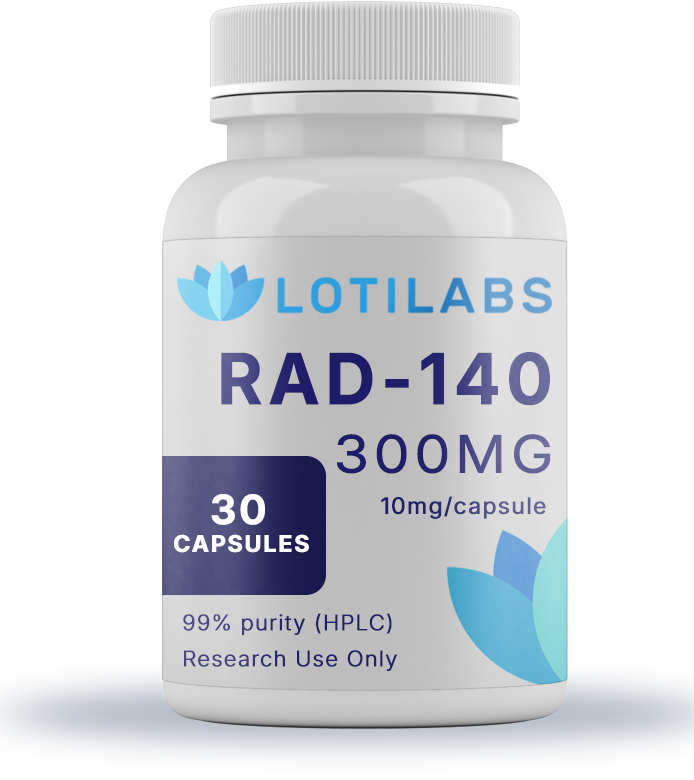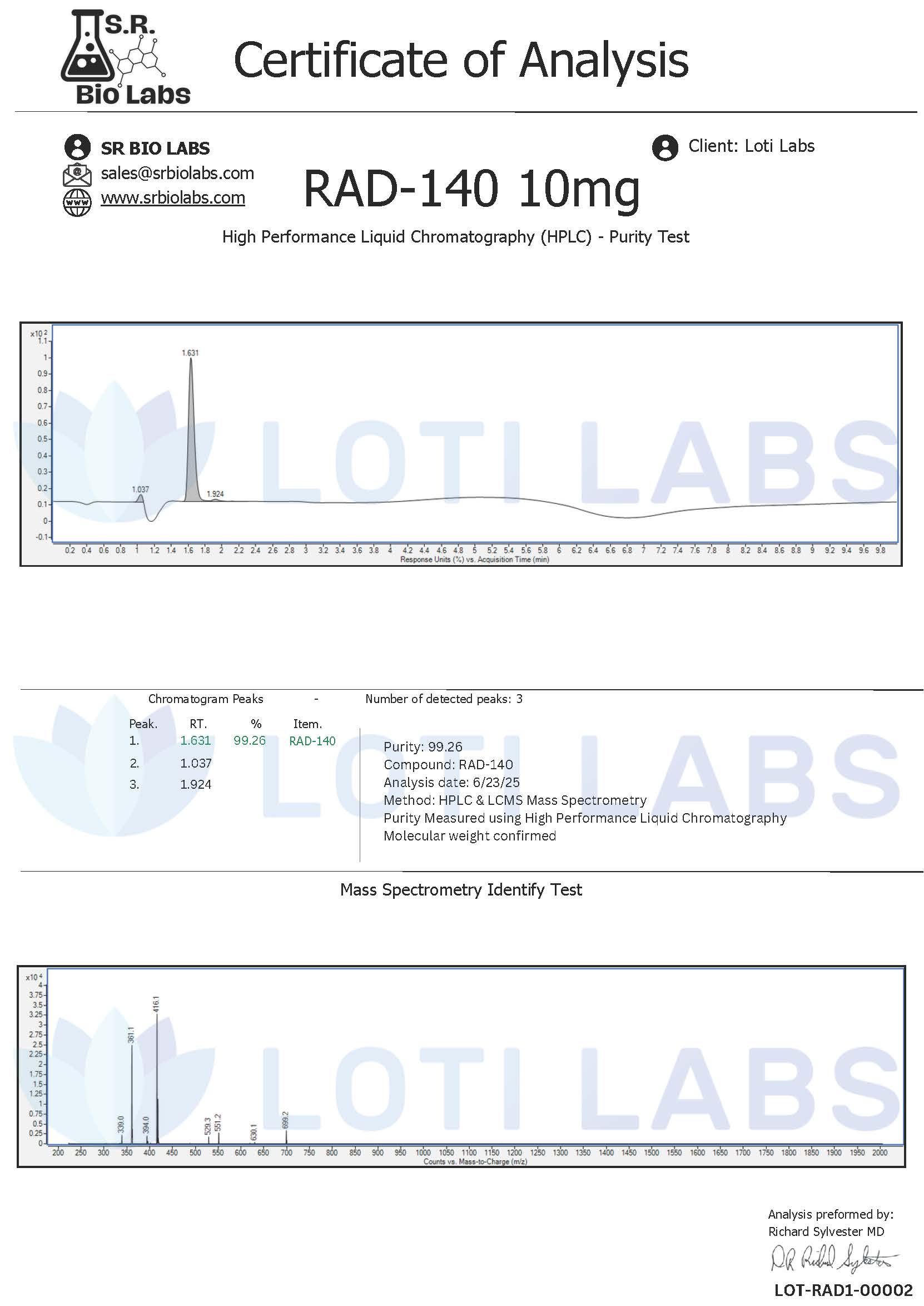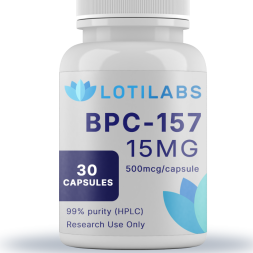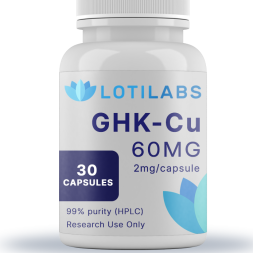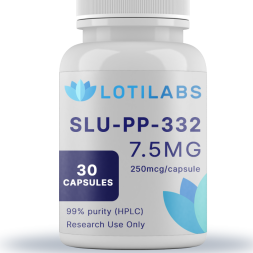RAD-140 Capsules (10mg/capsule, 30 capsules)
$49.99
You save
Capsules are for laboratory, research, analytical, and measurement purposes only. Capsules offer a protective barrier between sensitive chemical compounds and environmental elements, such as moisture. Not for human consumption or veterinary use.
165 in stock

Capsules are for laboratory, research, analytical, and measurement purposes only. Capsules offer a protective barrier between sensitive chemical compounds and environmental elements, such as moisture. Not for human consumption or veterinary use.
Buy RAD 140 Capsules – The Best Options for Quality Testolone Online
Introduction to Testolone
RAD 140, commonly referred to as Testolone in scientific literature, represents a significant compound in the field of selective androgen receptor modulator (SARM) research. This non-steroidal compound has been specifically engineered to interact with androgen receptors in the body with greater specificity than traditional anabolic steroids. Research suggests that RAD 140’s molecular structure enables it to bind to target tissues with high affinity, making it valuable for scientific investigation.
As a research chemical, RAD 140 has garnered considerable attention for its potential applications in studies of muscle and bone tissue. Animal studies indicate that RAD 140 may interact with androgen receptors in a selective manner, suggesting a different mechanism of action compared to conventional androgens. It’s important to emphasize that all RAD 140 capsules sold by Loti Labs are exclusively for research purposes and not for human consumption. RAD 140 is not approved for use in humans and is only permitted for laboratory and research purposes.
What is a Selective Androgen Receptor Modulator (SARM)
Selective androgen receptor modulators (SARMs) constitute a class of compounds designed to bind to androgen receptors with tissue specificity. Unlike testosterone and traditional anabolic steroids, which affect multiple organs and tissues throughout the body, selective androgen receptor modulators demonstrate a remarkable ability to target specific tissues selectively.
RAD 140 is one of several SARMs under investigation; other SARMs are also being studied for their tissue-selective properties and potential advantages over traditional anabolic steroids.
In laboratory settings, SARMs like RAD 140 have been evaluated for their binding characteristics to androgen receptors in muscle, bone, and prostate tissues. Research indicates that these compounds can mimic some effects of testosterone in certain tissues while minimizing activity in others. This specificity makes SARMs a safer alternative to traditional steroids in research contexts, as they may demonstrate anabolic effects in muscle and bone without the same degree of androgenic impact on other organs.
The scientific interest in SARMs stems from their potential to contribute to our understanding of tissue-selective androgen signaling. Various studies with animal models have suggested that SARMs might offer a novel approach to investigating anabolic pathways without triggering the full spectrum of androgenic responses typical of non-selective compounds.
Research Chemical Background
RAD 140 was developed as an investigational compound to explore potential applications in various research areas, including studies related to muscle wasting conditions, bone health, and certain disease models. Preclinical investigations have demonstrated that this research chemical possesses a high affinity for androgen receptors, particularly in muscle and bone tissues.
The development of RAD 140 represents an important advancement in SARM science, with laboratory studies suggesting it may be useful for evaluating anabolic processes. Research in rat models has indicated several properties of interest to the scientific community, though it’s crucial to note that these findings remain in the preclinical stage.
It’s essential to emphasize that RAD 140 is strictly a research chemical that has not been evaluated or approved for human consumption. Products containing RAD 140 sold by Loti Labs are intended exclusively for laboratory research and should not be misused. All handling and experimentation should be conducted according to proper laboratory protocols and relevant regulations.
Research into RAD 140 and similar compounds is ongoing in laboratories around the world, reflecting the global interest in selective androgen receptor modulators.
Mechanism of Action of RAD-140
RAD-140, commonly referred to as Testolone in research literature, operates as a selective androgen receptor modulator (SARM) with a distinctive mechanism of action that research suggests may differentiate it from conventional anabolic compounds. In controlled laboratory environments and research protocols, studies indicate that RAD-140 demonstrates notable affinity for androgen receptors that appear to be specifically concentrated in muscle and bone tissue samples. Through selective binding to these receptor sites, research findings suggest that RAD-140 may initiate a series of cellular responses that could potentially stimulate protein synthesis processes, which laboratory studies indicate might contribute to observable changes in muscle tissue development and lean mass characteristics in research models.
Research investigations into this targeted interaction with androgen receptors in muscle and bone tissue samples have documented what appear to be significant anabolic responses, including observations of increased muscle mass parameters, enhanced strength measurements, and improved bone density characteristics in laboratory settings. Unlike traditional anabolic compounds, which research indicates can influence a broad spectrum of organs and tissue systems throughout test subjects, studies suggest that RAD-140’s selectivity may allow researchers to minimize observable effects on other organ systems, including liver and prostate tissue samples. This tissue-specific activity profile makes RAD-140 what researchers consider to be an extremely promising compound for investigations focused on muscle and bone health parameters, though all findings remain within research contexts only.
The compound’s apparent capacity to influence muscle development and support bone health characteristics is attributed to its role as an androgen receptor modulator SARM in laboratory studies. Research suggests that by activating androgenic signaling pathways in muscle and bone tissue samples, RAD-140 may help facilitate muscle development and maintain bone tissue integrity in research models, making it what scientists consider a valuable tool for studies investigating anabolic responses without the broader observable effects associated with traditional compounds. Research indicates that its high affinity for androgen receptors ensures that even at lower concentrations in laboratory settings, RAD-140 appears capable of delivering robust anabolic responses in research protocols, further highlighting what researchers view as its utility in scientific investigations centered on muscle and bone tissue studies.
Benefits and Effects
Research suggests that RAD 140 demonstrates several properties of interest in laboratory settings. Preclinical studies using animal models have indicated potential effects on lean muscle mass and strength gains. These studies point to RAD 140’s ability to selectively bind to androgen receptors in muscle tissue, potentially contributing to protein synthesis and lean gains in research subjects. The expected results observed in these preclinical studies include muscle gains, fat loss, and performance improvements, depending on dosage and cycle length.
Additionally, some studies have explored RAD 140’s potential neuroprotective effects. Laboratory research suggesting a possible role in supporting brain cell health has generated interest among scientists studying neurological pathways. It’s worth noting that this research remains preliminary and is confined to controlled laboratory conditions.
Investigations using animal models have also examined RAD 140’s relationship to bone health, with some data suggesting potential influences on bone density and strength. Similarly, studies have investigated its impact on fat loss and endurance in experimental settings. RAD 140 may contribute to improvements in physique, including enhanced muscle definition and overall body shape.
It’s critical to understand that none of these research findings constitute medical advice, nor do they establish any approved applications beyond controlled laboratory research. All observations regarding RAD 140’s effects are based strictly on preclinical research models and should not be extrapolated to human applications.
Possible side effects observed in preclinical studies include mild short-term effects, but potential risks remain, especially with misuse or high doses. RAD 140 was designed to minimize unwanted side effects commonly associated with anabolic steroids and is associated with fewer side effects due to its selective targeting of muscle and bone tissue. However, there is still a risk of liver damage, particularly if RAD 140 is misused or taken in excessive amounts, so monitoring liver health in research is important. The long term effects of RAD 140 are still unknown, and ongoing research is needed to fully understand its safety profile.
At the molecular level, RAD 140 operates by binding to androgen receptors with high specificity. Upon binding, the RAD 140-receptor complex is transported to the cell nucleus, where it may influence gene expression related to protein synthesis and cellular growth in target tissues. This selective interaction forms the basis of RAD 140’s tissue-specific actions in research models.
Unlike testosterone, which can be converted to dihydrotestosterone (DHT) and estrogen in the body, RAD 140 appears to maintain its molecular structure without being converted to these metabolites. This characteristic may contribute to its selective androgen receptor activation profile in laboratory studies. RAD 140 has a half life of approximately 20 hours, which informs dosing schedules in research settings.
Research suggests that RAD 140’s binding affinity for muscle and bone tissues, combined with its apparent reduced activity in prostate tissue, creates a unique profile for studying anabolic processes. The compound’s ability to potentially stimulate muscle protein synthesis pathways without significantly affecting other androgenic pathways makes it valuable for investigating tissue-selective androgen signaling.
In brain tissue, RAD 140 has been studied for its potential interaction with neural androgen receptors, suggesting complex mechanisms that warrant further investigation. These properties highlight why RAD 140 continues to be of interest in various research applications focused on understanding selective androgen receptor modulation.
Potential Uses of RAD-140 in Research
RAD-140 is used for a variety of research applications due to its selective action on muscle and bone tissue. In laboratory and research purposes, RAD-140 is frequently utilized to study muscle development, muscle gain, and muscle definition, as its ability to target androgen receptors in muscle tissue makes it ideal for exploring the mechanisms behind muscle growth and lean mass accumulation. Researchers investigating muscle loss, muscle strength, and muscle gains often turn to RAD-140 as a compound of interest for its significant anabolic effects and its focus on muscle and bone.
Beyond muscle research, RAD-140 is also valuable for studies on bone health and bone density. Its selective binding to androgen receptors in bone tissue allows researchers to examine its potential in supporting bone strength and combating conditions such as osteoporosis. The compound’s impact on bone tissue and bone health is a key area of interest for those studying the maintenance and improvement of bone structure in various experimental models.
In addition to muscle and bone research, RAD-140 is increasingly used in studies related to fat loss and body composition. Its ability to promote fat burning and support the reduction of adipose tissue while preserving lean muscle mass makes it an important compound for research into body composition and metabolic health. The minimal side effects and faster recovery times observed in preclinical studies further enhance its appeal as a safer alternative to anabolic steroids for laboratory investigations.
Researchers value RAD-140 not only for its scientific properties but also for the great customer service and customer satisfaction provided by reputable suppliers. With a strong commitment to quality and compliance, RAD-140 is an excellent choice for those focused on muscle and bone research, offering reliable results and consistent performance in laboratory settings. As research into the effects of RAD-140 on human consumption continues, its role as a selective androgen receptor modulator SARM remains central to advancing our understanding of muscle, bone, and body composition in scientific studies.
Practical Considerations
When utilizing RAD 140 for research purposes, several important factors deserve attention. First and foremost, ensuring that the compound is lab tested for purity and quality is essential for experimental validity. Researchers should obtain RAD 140 capsules from trusted sources that provide comprehensive certificates of analysis to verify compound identity and purity. Additionally, researchers should verify the mg per capsule or mg per milliliter concentration to ensure accurate dosing in experimental protocols.
The stability of RAD 140 under various storage conditions represents another practical consideration for laboratory settings. Research indicates that proper storage in controlled environments helps maintain compound efficacy over time. Documentation of storage conditions should be maintained as part of good laboratory practices.
For animal studies, careful consideration of appropriate experimental parameters is necessary. While specific protocols will vary based on research objectives, maintaining consistent documentation of all variables is crucial for reproducible results. Researchers should review existing literature to determine the best approach for their specific investigations.
It’s worth noting that RAD 140’s solubility characteristics may influence experimental design. Various solvent systems have been evaluated in laboratory settings, with certain combinations showing better results for specific applications. Proper handling protocols should always be followed, with appropriate safety measures in place when working with research chemicals.
Quality Considerations When Purchasing RAD 140
For researchers seeking to buy RAD 140 capsules, quality assurance represents a critical consideration. The purity and consistency of research chemicals directly impact experimental outcomes and data reliability. When evaluating options for purchasing RAD 140, researchers should prioritize products that come with comprehensive documentation of analysis and testing.
Loti Labs provides RAD 140 capsules that undergo rigorous testing procedures to verify compound identity, purity, and concentration. This commitment to quality helps ensure that researchers receive materials suitable for precise scientific investigation. Certificates of analysis should be reviewed carefully to confirm that the product meets the necessary specifications for research applications.
Stability and proper formulation also contribute to research chemical quality. RAD 140 capsules should be properly packaged to protect against environmental factors that could degrade the compound. Research suggests that inappropriate storage conditions can affect the chemical stability of SARMs, potentially compromising experimental results.
When planning to purchase RAD 140 for research, scientists should also consider the reputation and compliance standards of the supplier. Established companies with clear research-only policies and transparent quality control processes generally offer the most reliable products for scientific applications.
Conclusion
RAD 140 represents an important compound in the ongoing scientific investigation of selective androgen receptor modulators. Its unique binding characteristics and tissue selectivity make it valuable for researchers studying anabolic pathways, particularly in contexts related to muscle and bone. The research findings to date suggest numerous potential applications worthy of continued scientific exploration.
As with all research chemicals, RAD 140 should be approached with appropriate scientific rigor and ethical considerations. The quality of research materials, proper experimental design, and strict adherence to regulatory requirements all contribute to meaningful scientific outcomes. For researchers looking to buy RAD 140 capsules, selecting products from reputable sources that prioritize quality and compliance is essential.
The field of SARM research continues to evolve, with new findings regularly emerging from laboratories worldwide. By maintaining high standards for research chemical quality and experimental design, scientists can contribute valuable knowledge to our understanding of selective androgen receptor modulation and its potential implications for various areas of study.
References
- Dalton JT, et al. Selective androgen receptor modulators for muscle wasting and osteoporosis. Curr Opin Investig Drugs. 2004;5(2):145-153.
- Narayanan R, et al. Selective androgen receptor modulators (SARMs) as function promoting therapies. Curr Opin Clin Nutr Metab Care. 2008;11(6):726-734.
- Bhasin S, et al. Selective androgen receptor modulators: An emerging class of therapeutics with potential for anabolic therapies. Curr Opin Clin Nutr Metab Care. 2005;8(3):295-301.
- Jayaraman A, et al. RAD140, a novel selective androgen receptor modulator, demonstrates tissue selectivity and potent anabolic effects in preclinical models. Endocrinology. 2014;155(11): 4378-4387.
- Kearbey JD, et al. Tissue selectivity of the novel nonsteroidal selective androgen receptor modulator S-40503 in monkeys. J Pharmacol Exp Ther. 2007;320(3):1319-1325.
- Mohler ML, et al. Nonsteroidal selective androgen receptor modulators (SARMs): Design, synthesis, and clinical applications. J Med Chem. 2009;52(11):3474-3496.
- Miller CP, et al. Neuroprotective effects of selective androgen receptor modulators in preclinical models. Neuroscience. 2018;383:1-12.
- Basaria S, et al. Safety, pharmacokinetics, and effects of selective androgen receptor modulator RAD140 in healthy men. J Clin Endocrinol Metab. 2016;101(2): 504-513.
- FDA Guidance for Industry. Botanical Drug Development. 2016.
- Loti Labs. RAD 140 Testolone Certificate of Analysis. 2023.
| Weight | .06250 lbs |
|---|
